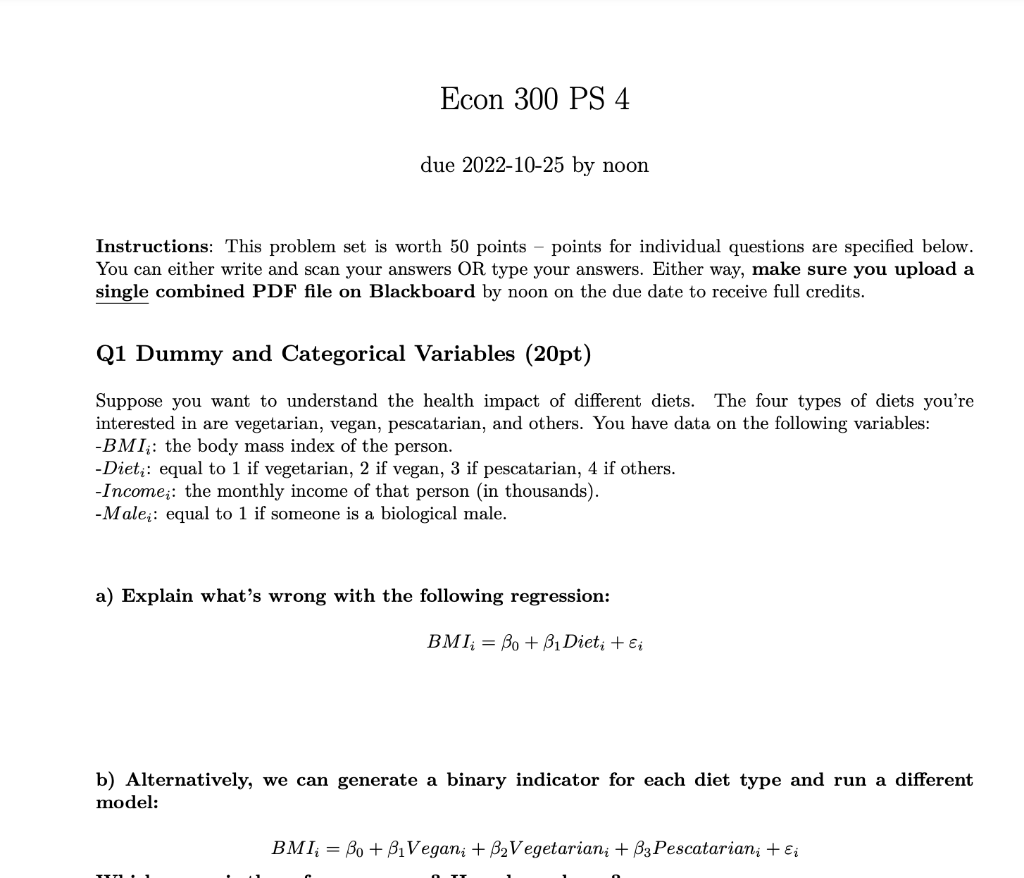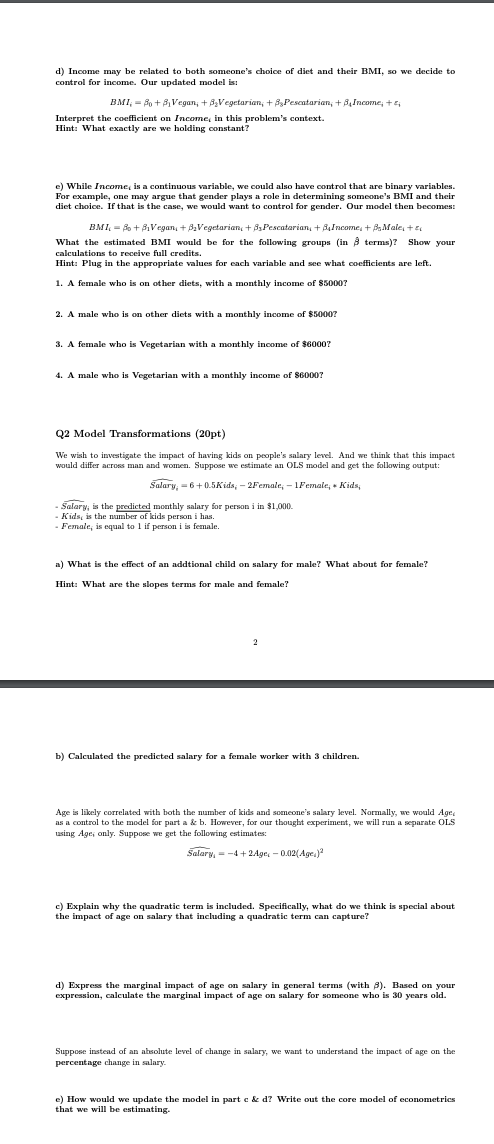

Instructions: This problem set is worth 50 points - points for individual questions are specified below. You can either write and scan your answers OR type your answers. Either way, make sure you upload a single combined PDF file on Blackboard by noon on the due date to receive full credits. Q1 Dummy and Categorical Variables (20pt) Suppose you want to understand the health impact of different diets. The four types of diets you're interested in are vegetarian, vegan, pescatarian, and others. You have data on the following variables: BMIi : the body mass index of the person. - Diet i: equal to 1 if vegetarian, 2 if vegan, 3 if pescatarian, 4 if others. - Income ei : the monthly income of that person (in thousands). Male i : equal to 1 if someone is a biological male. a) Explain what's wrong with the following regression: BMIi=0+1Dieti+i b) Alternatively, we can generate a binary indicator for each diet type and run a different model: BMIi=0+1Vegani+2Vegetariani+3Pescatariani+i d) Income may be related to both someone's choice of diet and their BMI, so we decide to control for income. Our updated model is: BMIi=0+1Vegan+2Vegetarian,+3Pescatarian,i+4Incomei+ci Interpret the coefficient on I ncome i in this problem's context. Hint: What exactly are we holding constant? e) While Income ei is a continuous variable, we could also have control that are binary variables. For example, one may argue that gender plays a role in determining someone's BMI and their diet choice. If that is the case, we would want to control for gender. Our model then becomes: What the estimated BMI would be for the following groups (in terms)? Show your calculations to receive full credits. 1. A female who is on other diets, with a monthly income of $5000 ? 2. A male who is on other diets with a monthly income of $5000? 3. A female who is Vegetarian with a monthly income of $6000 ? 4. A male who is Vegetarian with a monthly income of \$6000? Q2 Model Transformations (20pt) We wish to investigate the impact of having kids on people's salary level. And we think that this impact would differ across man and women. Suppose we estimate an OLS model and get the fallawing output: Salaryi=6+0.5Kidsi2Femalei1Femalei+Kids - Salary is the predicted moathly salary for persan i in $1,000. - Kids is the number of kids person i has. - Female, is equal to 1 if person i is female. a) What is the effect of an addtional child on salary for male? What about for female? Hint: What are the slopes terms for male and female? b) Calculated the predicted salary for a female worker with 3 children. Age is likely correlated with hoth the number of kids and someone's salary level. Normally, we woald Age as a control to the model for part a &b. However, for our thought experiment, we will run a separate OLS using Age, only. Suppose we get the following estimates: Salaryi=4+2Agei0.02(Agei)2 c) Explain why the quadratic term is included. Specifically, what do we think is special about the impact of age on salary that including a quadratic term can capture? d) Express the marginal impact of age on salary in general terms (with ). Based on your expression, calculate the marginal impact of age on salary for someone who is 30 years old. Suppose instend of an absolute level of change in salary, we want to understand the impact of age on the percentage change in salary. e) How would we update the model in part c \& d? Write out the core model of econometrics that we will be estimating. Instructions: This problem set is worth 50 points - points for individual questions are specified below. You can either write and scan your answers OR type your answers. Either way, make sure you upload a single combined PDF file on Blackboard by noon on the due date to receive full credits. Q1 Dummy and Categorical Variables (20pt) Suppose you want to understand the health impact of different diets. The four types of diets you're interested in are vegetarian, vegan, pescatarian, and others. You have data on the following variables: BMIi : the body mass index of the person. - Diet i: equal to 1 if vegetarian, 2 if vegan, 3 if pescatarian, 4 if others. - Income ei : the monthly income of that person (in thousands). Male i : equal to 1 if someone is a biological male. a) Explain what's wrong with the following regression: BMIi=0+1Dieti+i b) Alternatively, we can generate a binary indicator for each diet type and run a different model: BMIi=0+1Vegani+2Vegetariani+3Pescatariani+i d) Income may be related to both someone's choice of diet and their BMI, so we decide to control for income. Our updated model is: BMIi=0+1Vegan+2Vegetarian,+3Pescatarian,i+4Incomei+ci Interpret the coefficient on I ncome i in this problem's context. Hint: What exactly are we holding constant? e) While Income ei is a continuous variable, we could also have control that are binary variables. For example, one may argue that gender plays a role in determining someone's BMI and their diet choice. If that is the case, we would want to control for gender. Our model then becomes: What the estimated BMI would be for the following groups (in terms)? Show your calculations to receive full credits. 1. A female who is on other diets, with a monthly income of $5000 ? 2. A male who is on other diets with a monthly income of $5000? 3. A female who is Vegetarian with a monthly income of $6000 ? 4. A male who is Vegetarian with a monthly income of \$6000? Q2 Model Transformations (20pt) We wish to investigate the impact of having kids on people's salary level. And we think that this impact would differ across man and women. Suppose we estimate an OLS model and get the fallawing output: Salaryi=6+0.5Kidsi2Femalei1Femalei+Kids - Salary is the predicted moathly salary for persan i in $1,000. - Kids is the number of kids person i has. - Female, is equal to 1 if person i is female. a) What is the effect of an addtional child on salary for male? What about for female? Hint: What are the slopes terms for male and female? b) Calculated the predicted salary for a female worker with 3 children. Age is likely correlated with hoth the number of kids and someone's salary level. Normally, we woald Age as a control to the model for part a &b. However, for our thought experiment, we will run a separate OLS using Age, only. Suppose we get the following estimates: Salaryi=4+2Agei0.02(Agei)2 c) Explain why the quadratic term is included. Specifically, what do we think is special about the impact of age on salary that including a quadratic term can capture? d) Express the marginal impact of age on salary in general terms (with ). Based on your expression, calculate the marginal impact of age on salary for someone who is 30 years old. Suppose instend of an absolute level of change in salary, we want to understand the impact of age on the percentage change in salary. e) How would we update the model in part c \& d? Write out the core model of econometrics that we will be estimating








